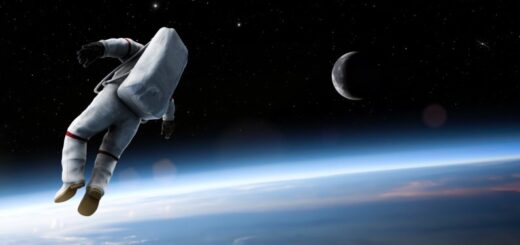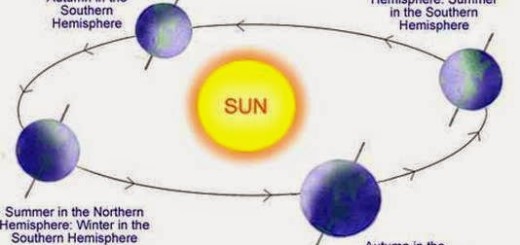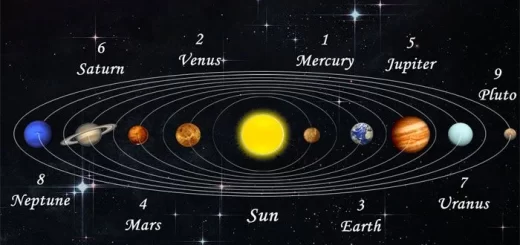Stars, Galaxies, Solar system, Planets, Moons, Asteroids, Meteors, Meteorites & Comets
Planets revolve around the Sun in fixed orbits due to the attraction force of the Sun to the planets. Mercury, Venus, Earth and Mars are called the inner planets because they are the nearest four planets to the Sun. The density of the inner planets is high because they consist of solid bodies. Jupiter, Saturn, Uranus and Neptune are called the outer planets because they are the farthest four planets from the Sun.
Celestial bodies
There are many bodies found in the universe such as stars, planets, moons,…..etc., these bodies are called celestial bodies. Celestial bodies are bodies that swim in space such as stars, planets, moons and rocky or gaseous bodies.
Stars
When you look at the sky on a clear moonless night, you will see a huge number of bright bodies called Stars. Stars are big-sized bodies that emit enormous amounts of heat and light. They appear small although they are big-sized because they are millions of kilometres away from us. The distance between stars is very large, so astronomers don’t measure them in kilometres, but with the Light year. Light year is the distance covered by light in one year and it equals 9.467 × 1012 km.
Distance in Light year = Distance in km/ 9.467 × 1012
When the distance between the Sun and a star is three light-years, this means that the distance between the Sun and this star = 3 × 9.467 × 1012 = 28.401 × 1012 km.
To calculate the distance in Light year: Calculate the distance in Light year between two stars, if the distance between them equals 37.868 × 1012 km.
Distance in light year = Distance in kilometre/ 9.467 × 1012 = 37.868 × 1012/ 9.467 × 1012 = 4 light years.
To calculate the distance in kilometre: Calculate the distance in kilometre between the Sun and a star, if the distance between them equals 5 Light years.
Distance in km = Distance in light year × 9.467 × 1012 = 5 × 9.467 × 1012 = 47.335 × 1012 km.
The stars seem as very small light points in spite of their big sizes because they are far from us. Astronomers do not measure the distances between stars in kilometres because these distances are too huge to be measured in kilometres.
Galaxies
The stars are found in groups called Galaxies. Galaxies are the greatest units that form the universe. They are a tremendous collection of stars. They are a system that consists of thousands of millions of stars. Our solar system belongs to the way of Chopped Hay galaxy or the Milky way galaxy.
Milky Way galaxy takes an oval shape with coiled spiral arms extending from it, the Sun lies on one of these spiral arms. The Milky Way galaxy is given that name because it appears in the sky at night as splashing milk or spreading straw. The celestial bodies are found in groups called Galaxies, Our galaxy in the universe is called The Milky Way galaxy which contains our solar system.
Astronomers discovered the celestial bodies with instruments called Telescopes. They are used for identifying the celestial bodies. Types of telescopes are reflecting telescope and refracting telescope.
Solar system
Through the astronomical explorations, astronomers knew that the solar system consists of some celestial bodies, the solar system consists of The Sun, Planets, Moons, Asteroids, Meteors, Meteorites and Comets.
The Sun
The Sun is the star of our solar system, it is the biggest body in the solar system, it lies in the centre of the solar system and the other bodies of the solar system revolve around it.
Planets
Planets are eight spherical opaque bodies that revolve around the Sun in one direction (anti-clockwise) in semi-circular or elliptical (oval) paths. The paths of planets lie in one plane perpendicular to the Sun‘s axis of rotation around itself. Planets revolve around the Sun in fixed orbits due to the attraction force of the Sun to the planets.
The arrangement of planets
According to their distances from the Sun (beginning from the nearest to the farthest) as follows: Mercury – Venus – Earth – Mars – Jupiter – Saturn – Uranus – Neptune.
According to their sizes (beginning from the biggest to the smallest) as follows: Jupiter – Saturn – Uranus – Neptune – Earth – Venus – Mars – Mercury) Smallest
Mercury is the nearest planet to the Sun, While Neptune is the farthest planet from the Sun, Jupiter is the biggest planet in the solar system, while Mercury is the smallest one, The nearest two planets to the Earth are Venus and Mars.
The Earth planet has the highest density. The Earth planet occupies the third-order according to the distance from the Sun, The fourth-order (ascendingly) according to the volume, The fifth-order (descendingly) according to the volume.
Classification of planets
The planets of the solar system are divided into two groups according to their distances from the Sun, which are the small or inner planets group, the big or outer planets group.
The small or inner planets group
The nearest four planets to the Sun are Mercury, Venus, Earth, and Mars, so, they are called the inner planets group. They are small, so they are called small planets. They are rocky bodies that have a solid surface. Their densities are high (ranging between 3.3 to 5.5 gm/cm³) because they consist of solid bodies. All of them have an atmosphere except Mercury. Mercury and Venus have no moons. The Earth has one moon, while Mars has two moons rotating around them.
The big or outer planets group
The farthest four planets from the Sun are Jupiter, Saturn, Uranus, Neptune, So, they are called the outer planets group. They are big, so they are called giant planets. They are gaseous bodies that are formed of gaseous elements in a solidified state (the most important of them are hydrogen and helium). Their densities are low (ranging between 0.7 to 1.3 gm/cm³) because they consist of gaseous bodies
All of them have an atmosphere. They have a large number of moons rotating around each of them. The presence of hydrogen gas in a solidified state on the surface of outer planets is due to the high pressure and extreme coldness on the surfaces of these planets.
The difference of gravity acceleration on the surfaces of the planets
The scientist Isacc Newton was the first one who discovered the Earth’s gravity force when he was standing under a tree and he found an apple falling down to the ground. Then he proved that there is a force of gravity (attraction force) between any two objects in space.
The forces of gravity depend on the mass of each object (directly proportional) and the distance between them (inversely proportional). The force of gravity differs from one planet to another according to the difference in its mass, where the gravity of the planet increases by increasing its mass and vice versa.
The object weight is changed from a planet to another due to the difference in the gravity acceleration from a planet to another. The ascending order of the planets according to the acceleration due to gravity on its surface: Mars, Mercury, Uranus, Venus, Saturn, Earth, Neptune, Jupiter.
The gravity on the Earth’s surface is larger than that on the Mars surface because the mass of the Earth planet is larger than that of the Mars planet and the force of gravity is directly proportional to the mass. Acceleration due to gravity is the largest on Jupiter planet, while it is the least on Mars planet. The Earth has the largest gravity on its surface in the inner planets.
Moons
Moons are followers (small space bodies) that are affected by the gravity of the planets that rotate around them. As in the case of our Moon, which is the follower of the Earth, the Moon is considered the follower of the Earth planet because the Moon rotates the Earth planet and it is affected by its gravity. Moons are considered the followers of the planets because they rotate around the planets and they are affected by their gravity.
Asteroids
Asteroids are thousands of different sized rocky masses that rotate around the Sun in a certain region called the belt of the wanderer asteroids which lies between the orbits of Mars and Jupiter. Asteroids are rocky space bodies of different sizes, most of them rotate in the region of the belt of the wanderer asteroids.
The belt of the wanderer asteroids is the region that separates the group of the inner planets from the group of the outer planets. Some of these rocky masses may emerge from their orbit around the Sun and swim in space, but some of them penetrate the Earth’s atmosphere in the form of meteors and meteorites.
Meteors
Meteors are small rocky masses that burn up completely when fall within the atmosphere of the Earth as a result of the heat produced from their friction with air and they can be seen as luminous arrows by the naked eye.
Sometimes, we see some luminous lines in the sky at clear nights due to the burning of small rocky masses when they penetrate the Earth’s atmosphere as a result of heat produced from their friction with air forming meteors.
Meteorites
Meteorites are large rocky masses that do not burn up completely when they penetrate the atmosphere of the Earth and the remaining part of them without burning falls on the Earth’s surface. The biggest meteorite till now has a mass of 80 tons and exists in the southern west of Africa. When a large asteroid (meteorite) penetrates the Earth’s atmosphere, its outer surface burns only and the remaining part without burning falls on the Earth’s surface.
Comets
Comets are masses of rocks, ice and solidified gases that revolve around the Sun in more elongated elliptical orbits intersecting with the orbits of the planets.
Structure of comet
The comet consists of two parts, which are the head and the tail. The head is the first part of the comet and it contains icy spheres, which are a mixture of solidified gases [carbon dioxide, nitrogen and methane gases], rocky parts, dust and water molecules. The tail is the second part of the comet and it is considered a gaseous cloud.
The most famous comet is Hally, which completes its revolution around the Sun every 76 years. No one can see Hally’s comet more than two times in his life because it completes its revolution around the Sun every 76 years.
Universe, Galaxies, Milky Way galaxy, Solar System, Origin of Universe & Stages of Big Bang
Nebular theory, Crossing star theory, Modern theory, Solar telescope & Hubble telescope
The Evolution of the Solar System and Solar Nebular theory
Solar energy (Sun), Ways of heat transfer (conduction, convection & radiation)
The solar system and the milky way galaxy
Fundamental Forces in nature, Gravitational forces, Electromagnetic forces & Nuclear forces



